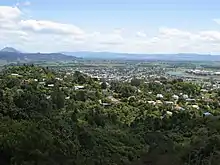Whakatāne District
Whakatāne District is a territorial authority district in the North Island of New Zealand. The Whakatāne District Council is headquartered in the largest town, Whakatāne. The district falls within the Bay of Plenty region. Judy Turner has been the mayor of Whakatāne since the 2019 local elections.[2]
Whakatāne District | |
|---|---|
 | |
| Country | New Zealand |
| Region | Bay of Plenty |
| District | Whakatāne District Council |
| Wards |
|
| Seat | Whakatāne |
| Government | |
| • Mayor | Judy Turner |
| • Deputy Mayor | Andrew Iles |
| Area | |
| • Total | 4,465 km2 (1,724 sq mi) |
| Population (June 2020)[1] | |
| • Total | 38,200 |
| • Density | 8.6/km2 (22/sq mi) |
| Time zone | UTC+12 (NZST) |
| • Summer (DST) | UTC+13 (NZDT) |
| Postcode(s) | |
| Area code(s) | 07 |
| Website | whakatane.govt.nz |
The district has an area of 4465 square kilometres, of which 4450 square kilometres are land.[3] The population was 38,200 as of June 2020.[1]
History
A Whakatane County Council was established in 1876, and covered a wider area than the present district, including Ōpōtiki. Whakatane Road Board was established at the same time.
The county was split into Whakatane and Opotiki counties in 1900, and the Road Board was made part of Whakatane County. In 1913, Whakatane Harbour Board was established, and in 1914, Whakatane Town became a separate entity from Whakatane County. The town became Whakatane Borough in 1917. Kawerau Town and Murupara Town District split in 1954 and 1955, and both became boroughs in 1962.
In 1976, Whakatane County, Whakatane Borough and Whakatane Harbour Board amalgamated to form Whakatane District. This expanded in 1989 by amalgamating with Murupara Borough, and taking parts of Opotiki and Taupo districts. [4][5]
Demographics
| Year | Pop. | ±% p.a. |
|---|---|---|
| 2006 | 33,300 | — |
| 2013 | 32,691 | −0.26% |
| 2018 | 35,700 | +1.78% |
| Source: [6] | ||



Whakatāne District had a population of 35,700 at the 2018 New Zealand census, an increase of 3,009 people (9.2%) since the 2013 census, and an increase of 2,400 people (7.2%) since the 2006 census. There were 12,468 households. There were 17,442 males and 18,258 females, giving a sex ratio of 0.96 males per female. The median age was 39.8 years (compared with 37.4 years nationally), with 8,013 people (22.4%) aged under 15 years, 6,177 (17.3%) aged 15 to 29, 15,303 (42.9%) aged 30 to 64, and 6,207 (17.4%) aged 65 or older.
Ethnicities were 63.2% European/Pākehā, 46.8% Māori, 3.0% Pacific peoples, 3.4% Asian, and 1.3% other ethnicities (totals add to more than 100% since people could identify with multiple ethnicities).
The proportion of people born overseas was 11.8%, compared with 27.1% nationally.
Although some people objected to giving their religion, 48.1% had no religion, 32.9% were Christian, 0.4% were Hindu, 0.1% were Muslim, 0.3% were Buddhist and 10.8% had other religions.
Of those at least 15 years old, 4,089 (14.8%) people had a bachelor or higher degree, and 5,925 (21.4%) people had no formal qualifications. The median income was $26,300, compared with $31,800 nationally. The employment status of those at least 15 was that 12,303 (44.4%) people were employed full-time, 4,389 (15.9%) were part-time, and 1,587 (5.7%) were unemployed.[6]
| SA2 name | Population | Dwellings | Median age | Median income |
|---|---|---|---|---|
| Allandale | 2,514 | 1,116 | 43.2 years | $25,000 |
| Coastlands | 1,776 | 624 | 40.5 years | $34,400 |
| Mokorua Bush | 1,395 | 588 | 49.8 years | $38,400 |
| Trident | 3,402 | 1,356 | 39.9 years | $22,600 |
| Whakatāne Central | 3,372 | 1,446 | 44.4 years | $25,300 |
| Whakatāne West | 3,336 | 1,143 | 31.9 years | $24,200 |
| Edgecumbe | 1,644 | 642 | 34.5 years | $25,200 |
| Murupara | 1,815 | 648 | 29.1 years | $18,800 |
| Ōhope | 3,177 | 1,350 | 51.8 years | $36,600 |
| Galatea | 1,407 | 612 | 34.0 years | $24,400 |
| Manawahe | 996 | 453 | 48.9 years | $33,900 |
| Matatā-Otakiri | 1,737 | 699 | 41.3 years | $31,100 |
| Onepu Spring | 1,221 | 459 | 44.4 years | $32,400 |
| Te Teko Lakes | 1,758 | 522 | 32.9 years | $19,800 |
| Thornton-Awakeri | 2,289 | 834 | 41.3 years | $34,200 |
| Waingarara-Waimana | 2,361 | 765 | 30.8 years | $21,200 |
| Wainui | 1,497 | 486 | 33.4 years | $26,600 |
Sister cities
Whakatāne has a friendship agreement with Shibukawa, Gunma, Japan.[10]
References
- "Population estimate tables - NZ.Stat". Statistics New Zealand. Retrieved 22 October 2020.
- "Judy Turner wins Whakatane District mayoralty". Sunlive. 12 October 2019. Retrieved 29 December 2020.
- "Data Table | Territorial Authority 2020 Clipped (generalised) | Stats NZ Geographic Data Service". datafinder.stats.govt.nz. Retrieved 25 September 2020.
- "Council History". Whakatāne District Council. Retrieved 29 December 2020.
- "Historical Information" (PDF). Whakatane District Council. December 2010.
- "Statistical area 1 dataset for 2018 Census". Statistics New Zealand. March 2020. Whakatāne District (025). 2018 Census place summary: Whakatāne District
- "2018 Census place summaries | Stats NZ". www.stats.govt.nz. Retrieved 14 December 2020.
- "International Exchange". List of Affiliation Partners within Prefectures. Council of Local Authorities for International Relations (CLAIR). Archived from the original on 4 March 2016. Retrieved 21 November 2015.
- "Sister cities". Whakatāne District Council. 25 November 2013. Archived from the original on 3 April 2019. Retrieved 15 May 2019.
- "Sister Cities". Whakatāne District Council. Archived from the original on 23 April 2012. Retrieved 31 December 2011.